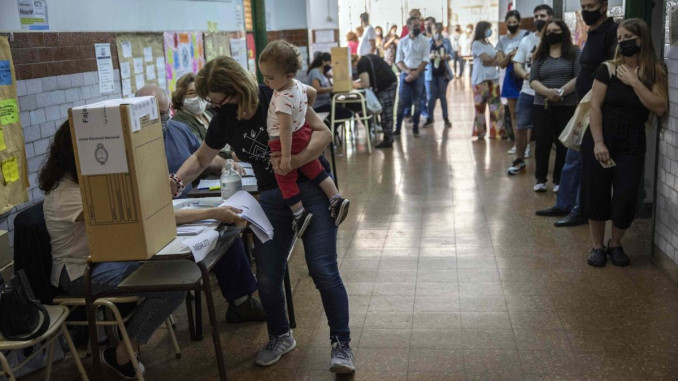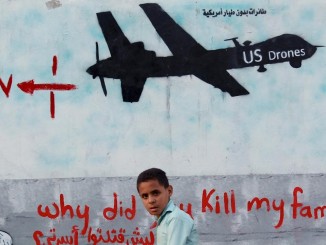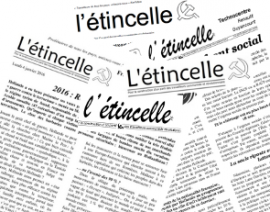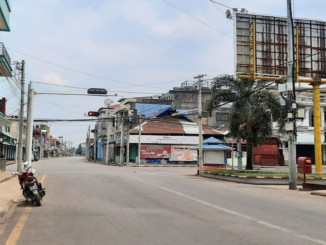
On November 14, Argentina held legislative elections to renew half of the Chamber of Deputies (in the country’s 23 provinces and the autonomous city of Buenos Aires), senators in one-third of the provinces, half of the provincial legislators (in half of the provinces) and municipal councilors in many municipalities across the country, including the 135 municipalities in the province of Buenos Aires.
This is a look at some of the highlights of an election marked by the defeat of the coalition in power, and popular anger that was partly expressed through the candidates of the Trotskyist extreme left, which made a significant breakthrough.
A slap in the face for the government’s adjustment policy
The “center-left” Peronist[1] government coalition (Frente de Todos, “Everyone’s Front”) suffered a major defeat at the national level, winning only 33.83% of the vote. It lost seats in the Chamber of Deputies but remains the largest minority, while it lost its majority in the Senate for the first time since the return of democracy in 1983.
The right-wing coalition, Juntos por el Cambio (Together for Change)[2], benefited greatly from the collapse of the Peronists (with a gap of more than eight points), but did not reach its 2019 level, let alone its 2015 level in terms of votes.
These results are a real slap in the face for the ruling coalition, which loses in fourteen provinces, several of which were its traditional strongholds, such as the province of Buenos Aires, or the province of Santa Cruz, where it only came third. It is clear that such results can only herald a major government crisis. However, the first reaction of Alberto Fernández, the current president of the government, who is now halfway through his term, was to celebrate these electoral results as “a triumph”! The celebration of the results by the main figures of Peronism (with the exception of the vice-president of the government, Cristina Fernández de Kirchner, who called in sick to justify her absence on the evening of the elections) conceals a form of relief at having partially limited the damage of the electoral results in September at the time of the primary elections, at least in the province of Buenos Aires[3].
The defeat was, in fact, expected. The bad results of the PASO (Open, simultaneous and compulsory primaries), coupled with a significant abstention (66% abstained, while voting is supposed to be compulsory) especially in working-class areas that usually voted for Peronist candidates was a preview. These results were the result of a budgetary adjustment policy with catastrophic consequences for the population, which is suffering the full force of the increase in poverty (40% of the population is poor, 70% of children are poor in Greater Buenos Aires) and galloping inflation (51% over the year) that salaries are not catching up with. It was also a punishment for the government’s management of the pandemic, which killed 116,000 people in Argentina and plunged millions of people living in the informal economy into poverty, while President Fernández was caught organizing birthday parties in the presidential residence.
But while Alberto Fernández pretended to get the message from the ballot box by promising to put “some money back into the pockets” of the people, the cabinet reshuffle after the election defeat made his real intentions clear: he reappointed the Minister of the Economy, Martín Guzmán, a symbol of support for big business and the main actor in the discussions with the IMF for a new agreement, placed Juan Manzur, a conservative anti-abortionist and member of Opus Dei, as chief of staff, and made Aníbal Fernández, a hardliner in matters of repression, the Minister of Security. However, he was careful to give billions to the provinces and municipalities, especially those in the historic strongholds of Peronism, hoping to win back some votes.
The challenge that the Frente de Todos had set itself to win over the working people who had turned their backs on it at the time of the primaries did go as planned. The Peronists gained more than a million votes between September and November, thanks to the increase in participation (which rose by five points to 71%, the lowest score since 1983). Thanks also to the efforts of the government machine using the “punteros” (a kind of local leader) who are in charge of many neighborhoods and who didn’t hesitate to go looking for the PASO abstentionists one by one, or to deploy a contingent of cars in all the suburbs of Buenos Aires to go searching for the inhabitants in their homes and bring them to the polling station.
The dynamic campaign of the extreme left towards the workers and the popular sectors
The good news of these elections is the important and unprecedented results of the revolutionary far left. With 6.16% of the vote nationwide, but more importantly, with 1.4 million votes (more than half a million in the province of Buenos Aires), the Left Workers Front-Unity (FIT-U) emerged as the third political force[4].
It obtained four deputies in Congress, renewing not only the two seats obtained in 2017 for the province of Buenos Aires with Nicolás del Caño (PTS), a former figure of the student movement, and Romina del Plá (PO), a high school teacher, union leader and leading figure in the abortion rights movement), but obtaining for the first time a seat for the autonomous city of Buenos Aires (with Myriam Bregman (PTS), a human rights lawyer), as well as a seat for the province of Jujuy (with Alejandro Vilca (PTS), a garbage collector from the colla community).
The revolutionaries also obtained provincial legislators for the city of Buenos Aires (Gabriel Solano (PO) and Alejandrina Barry (PTS)) and for the province of Buenos Aires (Guillermo Kane (PO) and Graciela Calderón (IS)). All of them will leave their seats to others in the FIT-U during their term of office, according to a complex system of rotation established within the FIT-U to respect a certain balance between the different groups in the coalition.
A noteworthy fact of these smaller-scale elections, but no less significant, is that for the first time the FIT-U won a dozen city councilors in several working-class cities in Greater Buenos Aires, strongholds of Peronism (Moreno, Merlo, La Matanza, José C Paz[5], and probably Florencio Varela and Morón, where the scores are very close), as well as in Coronel Pringles in the south of Buenos Aires province. This is a small feat, given that the thresholds for entry into these municipal councils are around 8 or 9%, the result of a patient work of implantation, especially on the part of the Workers’ Party (PO) through its intervention among unemployed and precarious workers.
Thus, Sandra Becerra, who will enter the municipal council of José C Paz with another comrade of the FIT-U, is a figure from the piquetero[6] movement – a movement of the unemployed–where she has been involved for twenty years and of the Workers’ Pole (piquetero organization linked to the Workers’ Party- PO), in this municipality of the second belt of the suburbs of Buenos Aires. Her house, occupied in 2011 after a mobilization that allowed access to housing for 150 families, houses not only one of the many popular canteens of the Workers’ Pole, but is also a school where dozens of residents, starting with Sandra herself, are coming to finish their primary or secondary studies.
The results of the extreme left, which were particularly strong in the working-class neighborhoods, show that the FIT-U was able to capture part of the popular anger through the perspectives it put forward: a general increase in salaries and pensions, the distribution of work among all, the refusal of the adjustment policy and the agreement with the IMF, the non-payment of the debt, etc. The revolutionaries have thus captured part of the vote usually given to Peronism, on the basis of significant discontent in the population. A shift perceived by FIT-U activists (who in the days leading up to the elections all had an anecdote to tell about a friend who was usually a fervent supporter of the Peronists and who would vote this time on the far left)… as much as by the local leaders of the Peronist strongholds, who were quick to react with the dirtiest means: attempts at intimidation (like, among others, this aggression in the Almirante Brown neighborhood a few days before the elections, denounced by the militants of the Socialist Left, who were attacked with fists and truncheons by five big men who said they were “defending the posters of the justicialist[7]” mayor, and threatened to take out their weapons… ), and other calls for electoral fraud (in Merlo, for example, the Peronist mayor called for the theft of all FIT-U ballots on election day… practices that have been used elsewhere in the province of Buenos Aires or in Jujuy, where FIT-U has denounced the defacement or theft of ballots, sometimes replaced by ballots from previous elections).
After weeks of a very dynamic campaign during which FIT-U activists engaged in a flood of events and rallies, especially in working-class neighborhoods and working-class strongholds “from Jujuy to Tierra del Fuego”, the activists and supporters of the different components of FIT-U had to make special efforts to “defend” the votes until the last moment, deploying thousands of poll observers (authorized by each party to control the electoral process) in the polling stations of the country: 20,000 in total were deployed by the Workers’ Party alone, with 12,000 in the province of Buenos Aires. In the province of Jujuy, in addition to the 350 observers deployed by the Workers’ Party and its picket organization the Workers’ Pole, other organizations of the unemployed (the Teresa Rodríguez Movement – 12 de Abril and the Darío Santillán Popular Front) were particularly involved in the campaign and in the oversight of the elections.
This is not the first time that the Argentine far left has won deputies at the national and provincial levels who try to be a platform for voicing the demands of the workers and support the struggles inside these institutions. But the result of these elections, with an increase in the Congress and this new implantation in the working class suburbs of Buenos Aires, in the historic strongholds of Peronism, represent a qualitative leap… and obviously poses new challenges in terms of implantation, structuring and formation, especially in the context of political instability that could well open up.
The Trump and Bolsonaro-style far right is making progress
While the breakthrough of the revolutionaries was partly at the expense of the traditional government parties, there is another sector that stands out in these elections: an ultra-liberal or “libertarian” far right, embodied, in particular, in the capital, by the monstrous Javier Milei (17.04% – two deputies and five legislators) and in the province of Buenos Aires by José Luis Espert (7.51% – three deputies and three legislators), where it placed itself as the third political force on a regional scale after a campaign conducted mainly on social networks and in the media.
Surfing on a certain rejection of the political system and the government, Javier Milei has succeeded in channeling part of the discontent by presenting himself on the right against the “political caste”, and by advocating “freedom” (like other right-wing and extreme right-wing currents in these times of pandemic). This economist is a disciple of Milton Friedman – fiercely anti-abortion, who denies global warming and calls it an invention of “socialism,” and a supporter of the “two demons” theory, which claims that the state terrorism perpetrated by the Argentine dictatorship was merely a response to far-left terrorism – has nevertheless succeeded in appearing as a “protester” to a fringe of the youth. In his rallies and among his supporters, there were also many admirers of Trump or Bolsonaro, but also of the military.
José Luis Espert, who was hardly less zany than Milei in his attitude. He also spent the entire campaign trying to pass off the old libertarian recipes as “anti-system”: reforming the labor code, limiting the right to strike, abolishing social benefits and lowering taxes, liquidating the status of teachers, etc.
The celebration of the results by these two energetic figures was a reflection of their campaign. Thus, the meeting at Luna Park stadium where Milei celebrated his election like a rock star was marked by the display among the crowd of a confederate flag, used by the extreme racist and supremacist right in the United States, some Gadsden flags and yellow snake flags, also regularly used by the American extreme right and pro-gun activists. Moreover, a security official threatened to brandish a gun against a supporter of Milei who sought to get on stage. For his part, Espert posted a video of himself proclaiming, “My first profound statement as an elected member of parliament (thank God I have immunity): I want boobs!”
The growing influence of this reactionary libertarian fringe is certainly not good news for the Argentine working class. The phenomenon seems to be confined to Buenos Aires and its province for the moment, but the entry of Milei and Espert into Congress could give them a more important platform. And while they spend their time denouncing “the caste,” they are careful to exclude right-wing opposition figures such as Mauricio Macri and Patricia Bullrich, with whom they hope to forge some alliances in the future.
An uncertain future
On the evening of the elections, and before the official results were published, President Alberto Fernández made a point of showing his colors for the rest of his mandate: nothing will be changed! On the contrary, he announced that he would soon present to Congress a “multi-year economic program” as part of the negotiations with the IMF and called on the “patriotism” of the right-wing opposition to support him in this step.
In early November, Argentina repaid $390 million in interest to the IMF and promises to pay another $1.9 billion in December, on a loan of nearly $45 billion that the Fernández government is seeking to renegotiate. Since the beginning of 2020, $12.4 billion has gone to pay the interest on a debt that is continuing to grow, placing the country in a situation of bankruptcy and in a vicious cycle of debt.
The Peronists in power rely on the bureaucratic trade union apparatus to get the population and the workers to accept the adjustment measures necessary to continue paying the debt. Thus, on Wednesday, November 17[8], the leaders of the Argentinean CGT are calling on their rank and file to take to the streets in support of the government, for a demonstration that will end with a meeting whose only speaker will be Alberto Fernández. But if the opposition pretends to criticize the management of the Peronist government, the fact remains that it was Mauricio Macri himself, leader of the PRO (Republican Proposal) and Juntos por el Cambio, who signed the agreement with the IMF in 2018, and that the labor and pension reforms that the right wing is calling for are not going in any other direction than the one initiated by the Peronist government.
With the elections over, the future is uncertain, with a government depending on the cooperation of the opposition to carry out its negotiations with the IMF, all in a context of economic crisis and a critical social situation. It remains to be seen to what extent the electoral defeat of the Peronists will also affect its ability to impose its anti-worker attacks designed to finance the debt and the capitalists. Twenty years after the “Argentinazo”, the popular explosion of 2001 that made the president resign and the bourgeoisie tremble, there plenty of reasons for the deep anger of the exploited classes to explode again.
[1] From Juan Domingo Perón, who was President from June 1946 to September 1955, and from October 1973 to July 1974 after a period of exile. Bourgeois nationalist current with a strong popular base, especially through the trade unions.
[2] The Juntos por el Cambio coalition brings together several trends that are more or less liberal or conservative, nationalist, but also sectors of radicalism, Christian democracy, Peronism and social democracy.
[3] See the article in Convergences Revolutionnaires, September 19, 2021, titled Argentina’s elections open a governmental political crisis and new challenges for revolutionaries.
[4] The Left and Workers’ Front (FIT-U) has included three, and later four, Trotskyist organizations since 2010: the Socialist Workers’ Party (PTS, linked to the Revolutionary Communist Current-Permanent Revolution in France), the Workers’ Party (PO), the Socialist Left (IS) and the Socialist Workers’ Movement (MST).
In the province of Buenos Aires, by far the most populous, the vote was 6.83%; in the autonomous city of Buenos Aires it was 7.77%; in the province of Jujuy it was 25.08%, almost on a par with the Frente de Todos; in the province of Santa Cruz, the stronghold of the Kirchner family, it was 7.04%, to which must be added the 2.08% of the Nuevo MAS; and in the province of Neuquén it was 8.19%.
[5] José C Paz is a dormitory city where, according to government statistics, 22% of the population (almost 60,000 people) is at the highest level of the Index of Multiple Deprivations (an index that takes into account, among other things, access to education, basic services and housing quality).
[6] The piquetero movement refers to the movement of unemployed workers that developed in Argentina in the 1990s and played a leading role in the social explosion that followed the 2001 economic crisis. The term refers to one of the movement’s preferred methods of action, the piquetes, which consist of blocking roads, bridges and other strategic communication routes.
[7] From the PJ, Justicialist Party, founded by Juan Domingo Perón, to which Alberto Fernández belongs, for example. Frequently used as a synonym for Peronist.
[8] On the occasion of the “Day of the Militants”, instituted on the anniversary of Perón’s return in 1972 after 17 years of exile, recalled by the bourgeoisie in an attempt to contain the upsurge of popular struggles, a final step before the military coup of 1976.




